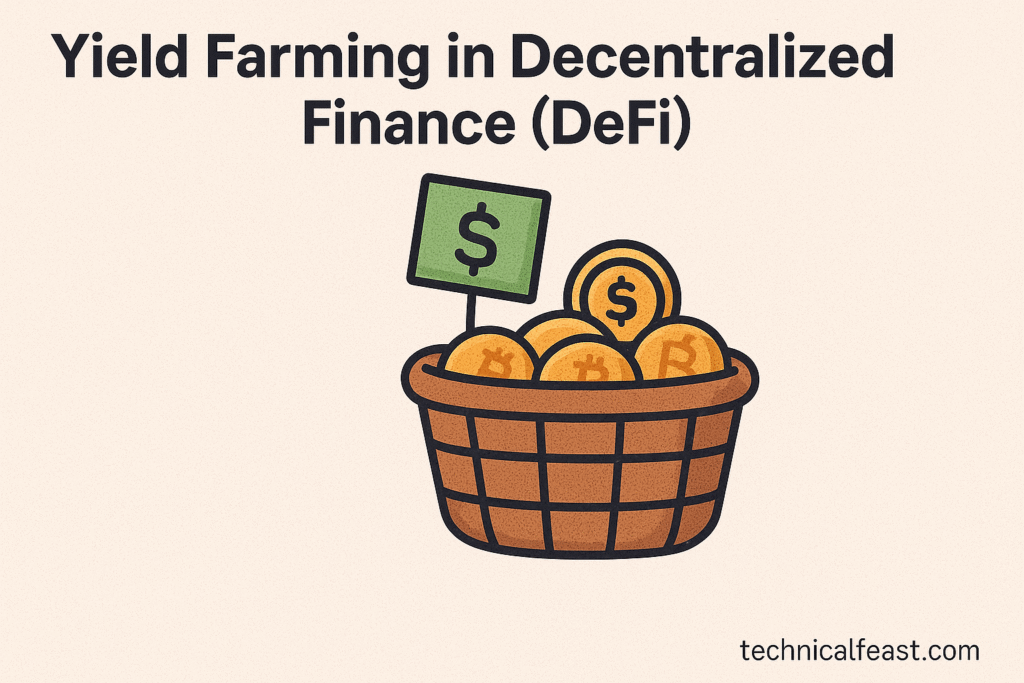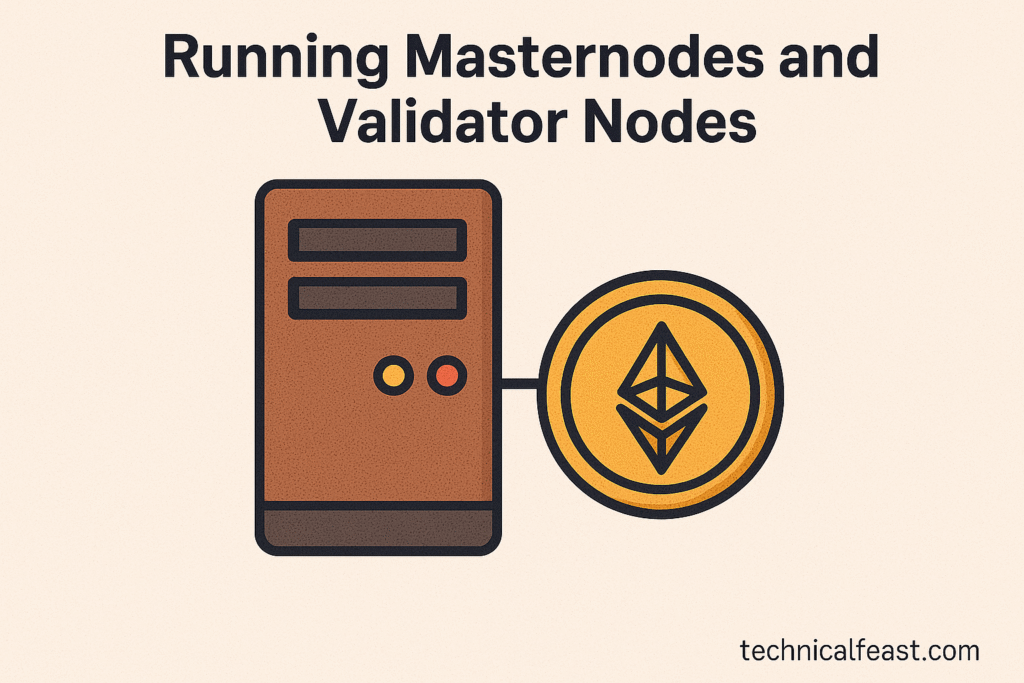Table of Contents
Crypto isn’t just for day trading – by 2025, passive income ideas using crypto have become increasingly popular. Many crypto investors now look for ways to make their coins earn rewards automatically. Unlike actively trading every day, passive strategies let your crypto sit and work for you. I’ve chatted with friends and read countless guides, and I can tell you there are fascinating, hands-off methods to earn more crypto. In this article, we’ll dive into the top 7 strategies that can earn you passive crypto rewards. Each idea includes real examples, expert tips, and concrete info from the latest sources. Whether you’re a HODLer or a curious newcomer, you’ll discover how to stake, lend, farm, and even rent NFTs to generate income. Let’s explore these passive income ideas using crypto together, step by step, as if I were explaining them over coffee to a friend.
1. Staking Cryptocurrencies
Staking is like earning interest on your crypto by helping secure a blockchain. In Proof-of-Stake (PoS) networks – such as Ethereum 2.0, Cardano, or Solana – validators lock up (stake) tokens to process transactions. In return, the network pays them rewards in the form of extra coins. This means you can put coins into stake and passively watch them grow. Britannica even notes, “Staking is a way long-term crypto investors (‘HODLers’) earn passive income in the crypto world”britannica.com. In practice, if you stake Ethereum, for example, you might earn 3–7% APY, whereas some altcoins offer double-digit rewards. As Koinly points out, “once you’ve staked your crypto, you’ll start earning passive income… APY can be in the higher double digits depending on the blockchain”koinly.io.
Staking comes in several forms:
- Solo staking: You run a full node (often requires a large minimum like 32 ETH on Ethereum) and keep your validator online 24/7. It gives the highest rewards (100% of them), but demands technical know-how and capitalcointracker.iocointracker.io.
- Pooled staking or Liquid staking: If you don’t meet high minimums, you can delegate to a staking pool or use a service (e.g. Lido, Rocket Pool, exchanges). This is easier but means sharing rewards and trusting a provider. Coinbase notes that on its platform you opt in to stake for a few taps and “earn rewards directly from the blockchain” without running your own nodecoinbase.com.
- Staked tokens: Some protocols give you a liquid token in exchange (like stETH or cbETH) which can be traded, so you can retain some flexibility even while staking.
Why staking is great: It’s hands-off – you lock your coins and periodically claim new tokens. As Gemini explains, “Staking crypto is a way to earn rewards in exchange for keeping assets invested in select cryptocurrencies… it can be a great way to make passive income”gemini.com. Coinbase also clarifies that staking APY is set by the blockchain (from transaction fees and new issuance), not by market pricecoinbase.com. In other words, if the network is healthy and growing, staking can yield stable returns, regardless of price swings.
Things to watch out for: Unlike a savings account, staked coins usually can’t be sold immediately – you may face lock-up or “unstaking” delays. There’s also slashing risk: if a validator misbehaves, you could lose a portion of your stake. As Coinbase warns, there’s a (small) chance of “losing your staked assets or rewards in case of a network or validator failure”coinbase.com. Always pick established networks and reputable staking providers.
Getting started:
- Choose your crypto: Pick a PoS coin you believe in (e.g. ETH, ADA, DOT, SOL). Research current staking rates and requirements.
- Select a platform: You can stake directly on wallets (like MetaMask for Ethereum Lido staking), on exchanges (Coinbase, Binance, etc.), or use decentralized protocols. Compare fees and lock-up periods.
- Delegate or stake: Follow the steps to lock up your tokens. For example, on Ethereum one might send ETH to a staking contract (via an interface) and start earning. With Lido, you stake via their site and receive stETH in returncointracker.iocoinbase.com.
- Claim rewards periodically: Some networks auto-reward you, others require claiming. Reinvest or hold your rewards!
Personal note: I started staking Cardano (ADA) a few years ago by delegating to a pool. It consistently gave me 4–5% APY. Not a windfall, but better than any bank offered, and literally zero effort. Watching my stake slowly rise over months was encouraging – I just let the protocol do the work. Overall, staking remains one of the simplest passive income ideas using crypto: once set up, it needs almost no attention, yet keeps delivering in small, steady doses.
2. Yield Farming in Decentralized Finance (DeFi)

Yield farming (also called liquidity mining) is a more advanced way to earn passive returns by providing liquidity to DeFi protocols. In practice, you lend or stake your crypto assets in smart-contract-based pools. In return, you collect fees and often extra bonus tokens. For example, a popular yield farm might let you lock up USDC-ETH on a DEX and earn trading fees, plus tokens like UNI for incentivizing liquidity. As Blockpit explains, “Yield farming involves lending or staking cryptocurrencies in DeFi platforms to earn returns… by providing liquidity to various protocols”blockpit.io. It’s attractive because the potential returns can be very high and flexible: you can move your assets to whatever protocol pays best.
In 2025, yield farming continues to be dynamic:
- LP Tokens: When you deposit in a pool (e.g. on Uniswap, SushiSwap, PancakeSwap), you receive LP tokens that represent your share. Those LP tokens accrue value from trading fees proportionally to your stake. Sometimes the platform also gives governance tokens as extra reward.
- DeFi Lending/Yield Aggregators: Some platforms like Aave or Curve automatically distribute interest or governance tokens for locking assets. Others (like Yearn Finance) algorithmically shift your funds between protocols to maximize yield.
- Example: Suppose you provide $1,000 of USDC-ETH into a popular pool. If the pool charges fees and the token prices stay relatively stable, you might see 20-30% annual return or more (though this varies greatly). Indeed, Koinly mentions that certain programs have offered “triple-figure” interest rates for some coinskoinly.io – though these higher returns usually come with higher risk.
However, yield farming carries significant risks:
- Smart Contract Risk: DeFi protocols can be hacked or have bugs, potentially draining your funds.
- Impermanent Loss: If one of the assets in the pool moves sharply in price, you could lose out compared to holding them. Blockpit warns of “the risk of impermanent loss, where changes in the prices of pooled assets can lead to lower returns compared to simply holding the assets”blockpit.io. In other words, if ETH price jumps 50% while in a pool with a stablecoin, your LP position might be worth less than just keeping ETH and USD separate.
- Complexity: Managing multiple pools and strategies is more hands-on. It requires tracking and sometimes moving assets to chase better yields.
Despite this, yield farming can be lucrative. Koinly notes that entering a liquidity pool usually earns you “a percentage of the fees, as well as sometimes other tokens – like governance tokens”koinly.io. That quote refers to liquidity provision, but it captures the idea: traders pay fees, and farms pay rewards. Some farmers in 2021 reported earning 30–100% APY by staking stablecoin pairs or less-volatile pools.
How to farm safely:
- Stick to reputable platforms and blue-chip pools (ETH-stable vs. small unknown tokens).
- Consider using stablecoin pools to minimize volatility risk.
- Start small to learn and monitor your position.
Case study: One crypto friend tried yield farming on the Curve platform in early 2024. He put $2,000 worth of DAI-USDPool LP (two stablecoins) into a Curve pool. Since Curve focuses on stablepairs, impermanent loss was minimal. He earned roughly 5-10% APY in trading fees plus extra CRV token rewards, netting him around $200 extra in the year. Not astronomical, but combined with staking on the side, it boosted his portfolio. When we talked, he emphasized compounding: every month he reinvested his earned CRV to increase his pool stake, demonstrating how farming can snowball over time. This realistic example shows yield farming can be a steady earner if you pick the right pools and stay informed.
3. Crypto Lending and Interest Accounts
Another well-known passive strategy is to lend your crypto or deposit it into interest-bearing accounts. Just as you’d earn interest in a bank savings account, many crypto platforms will pay you interest for lending them your coins. This can be done in centralized ways (through exchanges or CeFi apps) or decentralized (through smart contract protocols).
- CeFi platforms: Services like Nexo, Crypto.com Earn, or Binance Earn let you deposit crypto or stablecoins and promise interest (e.g. 3–12% APY) paid in crypto. For instance, these platforms may lend your assets to institutions or margin traders and share the interest with you. Koinly notes that “crypto interest-bearing platforms are offering far better interest rates than traditional financial institutions with interest rates in the triple figures for many popular coins”koinly.io. (The “triple figures” example often comes from high-yield promotions or volatile coins, but it highlights that rates can be exceptionally high compared to bank savings.) However, as Koinly also warns, some platforms skyrocketed in popularity before failing (and engaging in fraud)koinly.io. So choose only well-known, audited platforms with a good track record.
- DeFi lending: Protocols like Aave, Compound or Maker allow you to supply assets into a pool from which borrowers can take loans. In return, you earn a variable interest. For example, on Compound in 2024, supplying DAI stablecoin might yield 3–6% APY, while risky tokens could yield more or less depending on demand. Aave’s “stable rate” loans mean lenders get more predictable interest, whereas variable rates can fluctuate.
Why it’s appealing: You don’t need to sell your coins to earn. Your crypto keeps growing. Blockpit explains: “Crypto lending lets you earn stable and predictable interest income without having to sell your assets… You can generate passive income by lending your cryptocurrency to borrowers”blockpit.io. And indeed, many people use this as a hedge: hold Bitcoin for long-term, but earn 4–5% interest by lending it out.
Risks to note:
- Counterparty/platform risk: If a borrower defaults or a platform mismanages funds, your interest (and even principal) could be at risk. Some CeFi firms have gone bankrupt (e.g. Celsius, BlockFi) causing customers to lose funds. Therefore, only use trusted platforms and consider using smaller, decentralized contracts where you retain control (but these too have hacks).
- Variable rates: Interest rates can change. If everyone starts borrowing the asset you lent, rates go up – good for you; if not, rates can drop.
- Over-collateralization: In DeFi, borrowers must over-collateralize (e.g., deposit $150 to borrow $100). If a borrower gets liquidated, the collateral is used to cover the loan. On the lending side, this mechanism mostly protects lenders but also adds complexity.
Example: In 2024, I tried a fixed strategy: I took some idle USDC stablecoin and deposited it in Aave. At that time, Aave was offering around 4% APY on USDC. Every day, the protocol added a tiny bit more USDC to my balance. Within a year, my $1,000 turned into roughly $1,040 without doing any trading. It’s not life-changing money, but effort-free gains. Meanwhile, my friend Yuki used Crypto.com’s Earn account with $5,000 of BUSD stablecoin at 10% APY (lockup for 1 year) and ended up with over $500 interest – illustrating how even holding stable assets can yield decent returns in crypto land. These passive income ideas using crypto, like lending, won’t get you rich overnight, but they accumulate steadily.
Practical steps:
- Choose a platform: For simplicity, you might start with a big exchange that offers lending (e.g., Binance, Kraken). For more control, pick a reputable DeFi protocol.
- Select asset: Stablecoins (USDC, USDT, DAI) often have good yields and less volatility. If you use volatile coins (ETH, BTC), be aware the value of your interest is still in that asset.
- Understand lock-ups: Some accounts require locking your crypto for a period to get the advertised rate.
- Diversify: Just like any investment, don’t put all your eggs in one basket.
Overall, crypto lending is like letting your crypto go on vacation – it’s out working and bringing back gifts (interest) while you relax.
4. Providing Liquidity on Decentralized Exchanges
Providing liquidity (liquidity mining) is a branch of yield farming focused on DEXs and liquidity pools. When you supply assets to a DEX pool, you enable others to trade those tokens easily. In return, you earn a share of the trading fees and sometimes additional tokens. Think of it as being a market-maker. If someone trades ETH for USDT on Uniswap, the fee they pay is distributed to all ETH-USDT liquidity providers.
Blockpit explains liquidity pools well: “By contributing to liquidity pools, you can earn passive income from trading fees in addition to potential rewards”blockpit.io. However, it also warns of impermanent loss: “This method comes with the risk of impermanent loss, where changes in the prices of pooled assets can lead to lower returns compared to simply holding the assets”blockpit.io. In practice, this means if you deposit two coins and one price skyrockets or crashes, your position could lose value relative to simply HODLing both coins separately.
How it works:
- You deposit two (or more) assets in a pool at a specified ratio (commonly 50/50). For example, $500 worth of ETH and $500 USDC into the ETH/USDC pool.
- The pool mints LP tokens representing your share. As people trade, each trade incurs a fee (e.g., 0.3%) that gets split among LPs.
- Your LP token can also earn protocol incentives. For instance, the DEX might give you bonus tokens (like UNI, SUSHI, or CAKE) as extra reward.
Real returns: These vary widely. A deep-blue DEX like Uniswap or Balancer sees huge volume, so even a small share in a big pool can yield attractive APY. For example, at times in 2023/24, providing liquidity to stablecoin pools could net ~10%+ yearly (mostly from fees). Providing liquidity to high-vol pools (like ETH paired with a volatile altcoin) might yield even more in fees but also much more risk of impermanent loss.
Example: A friend tried providing liquidity on SushiSwap in 2024. She put $200 ETH and $200 LINK in an ETH/LINK pool. She earned trading fees (she saw around $15 profit after a month) and SUSHI token rewards. However, by the end of two months, a sudden 20% drop in LINK’s price meant her total position was slightly less valuable than if she had just held ETH and LINK separately. She took it as a valuable lesson: liquidity providing can boost earnings in sideways markets, but you must be prepared for sudden price moves.
Tips for liquidity provision:
- Use stablecoin vs. stablecoin pools to avoid impermanent loss (e.g. USDC/USDT on Curve). Blockpit notes such pools have moderate to high efficiency and if you can navigate risks, they’re “a compelling opportunity to earn passive income”blockpit.io.
- Stick to major, audited protocols (Uniswap, Curve, Balancer, PancakeSwap) to reduce smart contract risk.
- Understand that your capital is actively engaged: you should check on it occasionally. Some platforms auto-compound fees into your pool share; others require manual claim.
In short, providing liquidity turns your crypto into a tiny exchange. You help the market work smoothly and in return, you share in every trade fee. It’s not entirely push-button – you have to choose the right pool and occasionally manage your position – but it’s a powerful way to generate crypto dividends from network activity.
5. Running Masternodes and Validator Nodes

A masternode is a type of node on certain crypto networks that performs special functions (like instant transactions or privacy features). Running one usually requires owning a large amount of that coin and operating a server. In return, the network pays the masternode operator (you) a share of block rewards. Essentially, masternodes create steady income streams for dedicated supporters of a network.
Blockpit describes masternodes: “Running a masternode offers high passive rewards by facilitating instant transactions, enhancing privacy, participating in governance… [and] it requires a significant initial investment and technical knowledge… If these benefits and requirements fit your profile, masternodes can be a highly effective method of generating a passive crypto income.”blockpit.io. In other words, yes, it can be lucrative, but you need the capital and skills.
Key points about masternodes:
- High entry cost: Many masternode coins have big collateral requirements. For example, Dash nodes require 1,000 DASH (often tens of thousands of USD). Smaller coins might require fewer tokens, but you still need enough to set up.
- Ongoing maintenance: You’ll need a reliable server (could be a cloud server or VPS) running 24/7. Uptime matters – if your node goes offline, you miss rewards.
- Rewards: They vary by coin. Some masternodes pay a few percent APY, others might be in double-digits. Coin Bureau notes masternode operators “are rewarded… by a percentage of the block reward”coinbureau.com, meaning they share in the network’s issuance.
- Coins that have masternodes: Dash is the classic example. Others include PIVX, Syscoin, Energi, and dozens of smaller projects. Research coin bureaus or masternode listing sites for current reward rates.
Benefits: Because you’re providing valuable infrastructure, your earnings are often quite stable per block. Coin Bureau highlights: “The main benefit… is that those who operate [masternodes] are able to earn cryptocurrency on an ongoing basis without having to get involved in actually mining the coins”coinbureau.com. So you skip hardware mining rigs but still get continual crypto payouts. Many operators enjoy the predictability: as long as you maintain the node, the block rewards come in.
Risks and downsides: Beyond the high cost, there’s currency risk: if the coin’s market price plummets, your staked capital can lose value faster than the block rewards compensate. Also, some masternode coins are relatively illiquid or not well-known, so research is crucial.
Getting started:
- Research coins: Use resources like Coin Bureau’s guides or masternode platforms to find coins with active networks and healthy markets.
- Calculate ROI: If a coin requires X tokens and pays Y tokens per block, calculate how many years it’ll take to break even at current prices. For example, if a coin yields 10 tokens per day and the coin is $1 each, that’s $10/day ~ $3,650/year. If the 10,000 token collateral cost $20,000, it’s ~55% annual, which is excellent.
- Setup a server: Most tutorials will guide you through setting up a masternode on a VPS (e.g., AWS, DigitalOcean).
Example: I once looked into running a PIVX masternode (which required ~10,000 PIVX). The reward was about 6% annual. I realized I’d need to invest thousands of dollars, so at that time I passed. But a tech-savvy friend did set up a DASH masternode back in 2022. He says it was a “set and forget” at first – profits came in daily without touch. That masternode earned him about 7% APR in DASH, which he either reinvested or sold for profit. He treated it like a fixed-income CD, but paid in DASH. In short, if you have the capital and interest in being a network validator, masternodes are a notable passive income idea using crypto – albeit a niche one.
6. Holding Dividend-Paying Crypto Tokens
Did you know some cryptocurrencies pay dividends? Yes, similar to stocks, certain tokens distribute a portion of fees or profits back to holders. This is a less-known but genuine passive-income idea. Essentially, by simply holding (and often staking) these tokens, you earn periodic rewards, sometimes automatically.
How it works: Many exchanges and DeFi platforms have governance tokens that share revenue. For example:
- KuCoin Shares (KCS): KuCoin crypto exchange created KCS. If you hold KCS in your account, KuCoin pays you a daily bonus. The bonus comes from 50% of the trading fees KuCoin collects, redistributed to KCS holders. Koinly explains: “KuCoin has the KCS token and KCS holders are paid daily dividends in KCS, based on 50% of the fees from users on KuCoin”koinly.io. So by holding KCS, you passively accumulate more KCS every day.
- Neo (GAS): Holding NEO automatically generates GAS tokens over time (GAS powers the Neo network). It’s often described as “earn GAS for holding NEO” – effectively a dividend.
- AscendEX (ASD), Crypto.com (CRO), others: Various platforms have their own token and reward schemes. For instance, AscendEX’s ASD pays out regular airdrop dividends to token holders.
Why do this: You simply keep assets in your wallet (or exchange account) and qualify for payouts. It’s very low effort. Blockpit likens it to corporate dividends: certain coins let you “earn passive income just by holding” because you share in trading fees or profitskoinly.io. It’s often overlooked, but if you believe in a platform long-term, holding its token can be lucrative. For example, back in 2021, Binance Coin (BNB) didn’t literally pay “dividends,” but Binance did buy back and burn tokens using part of its profits, indirectly rewarding holders through scarcity.
Things to consider: These tokens often have price volatility. Also, some require staking (e.g. you need to actively stake or lock them to earn), while others just need to sit. Always verify current yield: KCS holders might get a few percent yield per year (paid daily), whereas rewards of smaller tokens vary by platform activity.
Getting started:
- Identify dividend tokens: Look up tokens like KCS, CRO, Neo/GAS, STEPN (GMT gives rebates), etc. The crypto community often maintains lists of these.
- Understand rules: Does the platform require locking tokens? How are payouts delivered (e.g. monthly, daily)?
- Hold or stake: Follow the platform’s instructions to receive payouts. For example, keep KCS in your KuCoin account, or stake CRO on Crypto.com for bonus.
Real example: A colleague held 500 KCS tokens (worth about $5,000 at that time) on KuCoin. Every month, he received roughly 20-30 KCS (then ~$200) as a bonus. It felt like “getting paid just for Hodling,” and in a year it almost paid back all the transaction fees he paid for trades on KuCoin. This kind of passive dividend doesn’t make you rich overnight, but it nicely offsets costs.
In summary, dividend-paying cryptos are a creative form of passive income. By holding the right tokens, you can tap into a slice of a platform’s profits, making these holders among the smartest long-term investors.
7. Earning from NFTs (Royalties and Rentals)
Non-fungible Tokens (NFTs) are often thought of as speculative art or collectibles, but there are clever passive-income angles here too. Two main ideas: earning royalties on NFTs you create, and renting/leasing NFTs on specialized platforms. Both let you monetize digital assets over time.
1. NFT Royalties: When you mint an NFT on many platforms, you can specify a royalty percentage (commonly 5–10%). Every time your NFT is resold on a compatible marketplace, you automatically receive that cut. For instance, if you create a popular NFT art piece and it sells for 1 ETH, you might get 0.05 ETH as royalty if you set a 5% rate. Famous NFT artists (or any creator) can thus continue to earn whenever their work changes hands. This is passive because after the initial creation, you don’t do anything extra – the blockchain enforces the payment. Although it depends on continued interest in your NFT, it can yield ongoing income.
2. NFT Rentals/Rentals Protocols: Not all NFTs are art; some are utility, like virtual land, gaming items, or tickets. Now platforms like reNFT, NFTfi, or specialized marketplaces allow owners to rent out NFTs. Koinly describes reNFT: an “NFT rental protocol, where investors can loan (or rent) NFTs for a given time”koinly.io. For example, suppose you own a valuable gaming NFT (say a rare sword in a blockchain game). Another player might pay you some crypto to borrow that NFT for 1 week. You get paid for lending it out, and they get to use it in the game. It’s similar to lending money for interest, but with digital collectibles. Another case is renting virtual real estate or concert tickets as NFTs for events – people pay to use your NFT for a specific period. You earn rent in crypto, no extra work after listing it.
Examples:
- An NFT artist I know sells digital art on OpenSea. She set 10% royalties on all her works. Over 2024, several of her pieces were resold, and she earned about 0.3 ETH (~$1,000) in royalties – money she didn’t expect when first selling.
- In a blockchain game, one user listed his virtual land NFT for rent on a platform. Gamers paid daily rates in tokens. By renting the land out most days of the year, he earned the equivalent of a few percent yield on the land’s value annually, without actively playing.
Platform examples: Besides reNFT, there are lending platforms like NFTfi (collateral loans) and rental marketplaces like YUP or Quidd. New DeFi apps let you stake an NFT to earn tokens too (e.g. Axie Infinity staking).
Cautions:
- For royalties, the NFT must have market demand, or you get little or no resale.
- Rental income usually requires you to actively list and manage your NFT on a platform; it’s not entirely “set and forget.” But it is more passive than trying to flip NFTs for profit.
- Be aware of platform fees and terms: some take a cut of rental fees or require using their token.
Conclusion: NFTs can be passive earners through ongoing royalty streams or by renting out their utility. It’s a way for creators and collectors alike to keep making crypto from an asset, much like real estate owners earning rent.
Frequently Asked Questions
Q1: Are these passive strategies completely hands-off?
No investment is truly hands-off or risk-free. However, passive income ideas using crypto aim to minimize daily effort. For instance, staking requires a one-time setup and occasional check-ins (for rewards). Lending on a platform might require an initial deposit and periodic interest claims. Yield farming and liquidity providing often need more management (like moving funds between pools to chase yields). Always monitor your positions occasionally and adjust to market changes. Use reputable platforms and never invest more than you can afford to lose.
Q2: How much can I realistically earn?
Earnings vary widely by strategy and market conditions. Staking might net 3–15% APY (depending on the coin). DeFi strategies like yield farming or liquidity pools have ranged from 10% to well over 100% APY in boom timeskoinly.iokoinly.io, but those high yields often come with high volatility. Lending stablecoins on CeFi often yields 4–12%. Dividend tokens often give single-digit to double-digit annual returns from fees. NFTs are even more variable – royalties depend on resale volume. For a diversified approach, many crypto holders might see an additional 5–20% in crypto yield per year across their portfolio, rather than 0% (like a plain wallet).
Q3: What are the main risks?
Each method has its own risks. Staking risks include lock-up times and slashing (loss for network faults). Lending and CeFi accounts carry counterparty risk (platform failures) – many crypto lenders failed or froze in 2022-23, so always use trusted entities. DeFi strategies (yield farming, LP) have smart contract risk (hacks, bugs) and impermanent loss (assets diverging in price). Masternodes have high upfront cost and depend on coin stability. Dividend tokens rely on platform success (if an exchange folds, your token could crash). NFT methods depend on demand for the NFT. In all cases, regulation risk and crypto volatility apply. It’s essential to do your own research (DYOR) and maybe start small to test a strategy.
Q4: Is crypto passive income taxable?
Yes. Most jurisdictions treat crypto earnings as taxable income or capital gains. For example, staking rewards, interest from lending, and NFT royalties could all count as income when you receive themcointracker.io. If you later sell the crypto, it might also incur capital gains tax. Tax laws vary by country, so consult a tax professional or use tools like Koinly’s guides. (Koinly has detailed crypto staking tax info, for instancecointracker.iocointracker.io.)
Q5: How do I get started safely?
Begin by researching and understanding each idea before investing any funds. Reputable sources (like Gemini, Coinbase, Britannica) confirm that these methods are real but not without riskgemini.combritannica.com. Start with small amounts or test accounts. Use hardware wallets for large stakes and only interact with well-known platforms. For staking or lending on exchanges, enable security features (like 2FA). Diversify: maybe allocate a portion of your portfolio to staking, some to an interest account, and some to experimental DeFi. Join crypto communities (Reddit, Discord) to learn from others’ experiences. Over time, you’ll gain confidence and can allocate more. Remember: if something promises extremely high returns with no risk, it likely is too good to be true.
Conclusion: By 2025, the crypto ecosystem offers more passive income ideas using crypto than ever before. From staking in PoS networks to earning dividends from tokens and renting out NFTs, there are creative ways to make your digital assets work for you. Throughout this guide we saw how each strategy has its unique benefits and caveats. For example, staking can yield steady rewards with minimal effortgemini.combritannica.com, while DeFi yield farming can offer high returns at higher riskblockpit.ioblockpit.io. Dividend tokens and NFTs unlock more niche streams of incomekoinly.iokoinly.io. Remember that every method requires diligence: vet platforms, understand fees, and stay aware of market changes. The best approach is often diversification – mix a few of these strategies to spread risk and capture different rewards.
In the end, passive crypto income isn’t a magic bullet, but it can significantly boost your portfolio over time. As Lido’s CEO noted, staking and yield farming “have now grabbed an important spot in generating passive income for investors”nasdaq.com. With solid research, patience, and the tips in this article, you’ll be well-equipped to explore these ideas in 2025 and beyond. Let your crypto sit, work, and earn – and watch your holdings grow while you focus on other life goals.




Leave a Reply